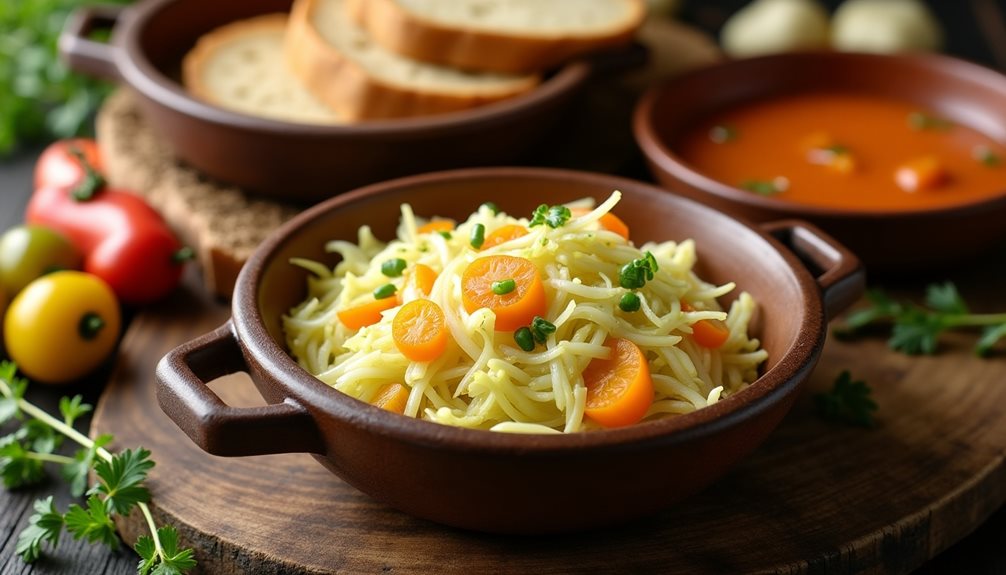Russian cuisine offers a wide variety of dishes that are both delicious and supportive of a healthy lifestyle. Many traditional Russian recipes use natural, minimally processed ingredients that provide important nutrients and promote overall well-being. For example, sauerkraut (квашеная капуста, kvashennaya kapusta [kva-SHEN-naya ka-POO-sta]) is a staple in many Russian households, especially in winter. Made by fermenting cabbage, sauerkraut is rich in probiotics, which are beneficial bacteria that help maintain a healthy gut, aid digestion, and support the immune system.
Hearty soups like pea soup (гороховый суп, gorokhovyy sup [ga-ROH-kha-vee soop]) are also common and healthy. Made with dried peas, root vegetables, and sometimes lean meats, this soup is high in fiber, which helps regulate blood sugar and promote heart health. The addition of vegetables brings in essential vitamins and minerals, while using lean meats keeps the dish low in saturated fat.
Whole grains such as buckwheat (гречка, grechka [GRYECH-ka]) and millet (пшено, psheno [pshe-NO]) are frequently served as side dishes in Russia. Both grains are naturally gluten-free and packed with important minerals like magnesium and iron. Buckwheat in particular is rich in antioxidants and can help lower cholesterol, while millet supplies B vitamins and supports energy levels.
Vegetable-based dishes are another highlight of Russian cuisine. Vinaigrette salad (винегрет, vinegret [vee-neh-GRET]) is a classic example, made with boiled beets, potatoes, carrots, pickles, green peas, and sometimes sauerkraut. This colorful salad is high in fiber and vitamins—especially vitamin C—and provides antioxidants from the beets.
Fish (рыба, ryba [REE-ba]) also plays an important role in Russian meals. Baked or steamed river fish provide high-quality protein and omega-3 fatty acids, which are beneficial for heart and brain health.
Traditional Russian meals tend to focus on moderation and balance by combining protein, complex carbohydrates, and vegetables in one meal. Many dishes are prepared by boiling, baking, or fermenting rather than frying, which helps reduce excess calories and unhealthy fats. To enjoy the healthiest aspects of Russian cuisine, it’s best to choose whole grains like buckwheat or millet over refined grains, include fermented foods for gut health, favor soups and salads packed with vegetables, and select lean proteins such as fish or legumes. These classic foods show that Russian cuisine can fit easily into a balanced diet while providing both comfort and variety.
The Flavor and Health Benefits of Traditional Russian Sauerkraut

Traditional Russian sauerkraut, known as квашеная капуста (kvashenaya kapusta), is much more than a simple side dish—it is a blend of centuries-old culinary tradition and modern nutritional science. This fermented food is recognized for its tangy, slightly sour taste and crunchy texture, achieved by fermenting shredded cabbage with salt. Often, grated carrots (морковь—morkov’) or cranberries (клюква—klyukva) are added to enhance both the flavor and the nutritional value. Carrots contribute a subtle sweetness and a vibrant orange color, while cranberries add a tart note and extra vitamin C. These ingredients make Russian sauerkraut not only more flavorful but also more nutritious.
The natural fermentation process is where sauerkraut’s real health benefits come into play. As the cabbage ferments, beneficial bacteria convert sugars into lactic acid. This gives sauerkraut its distinctive sour taste and preserves it for months without refrigeration. Most importantly, the fermentation process produces lactic acid bacteria (LAB), which are probiotics—these “good” bacteria support gut health by restoring intestinal microbial balance and helping inhibit the growth of harmful pathogens. Eating foods rich in probiotics, such as Russian sauerkraut, can aid digestion, improve nutrient absorption, and strengthen the immune system, especially after illness or antibiotic use.
Russian sauerkraut is also a great source of vitamin C, which was historically vital during long winters when fresh fruits and vegetables were scarce. The fiber content in sauerkraut supports healthy digestion and helps you feel fuller for longer, all while being low in calories. Traditionally, no vinegar is used in Russian sauerkraut; its sourness comes purely from natural fermentation. This method not only preserves the cabbage but also maintains its crunch and authentic flavor.
Versatile in the kitchen, Russian sauerkraut can be eaten on its own as a snack, served as a side dish with meats or potatoes, mixed into soups like щи (shchi), or added to salads for extra crunch. The long shelf life and nutritional benefits made it an essential food for surviving harsh Russian winters. In summary, traditional Russian sauerkraut brings together taste and well-being in every bite, offering a natural way to enjoy both culinary heritage and digestive health.
Nutrient-Packed Millet Porridge With Pumpkin
Millet porridge with pumpkin is a traditional Russian dish known for its impressive nutritional profile and broad appeal, especially among those seeking healthy, gluten-free meal options. In Russia, it’s called “пшённая каша с тыквой” (pshyonnaya kasha s tykvoy). This porridge combines the hearty, nutty flavor of millet with the natural sweetness and bright color of pumpkin, resulting in a comforting and nourishing breakfast or lunch.
Millet is a small, round whole grain that is naturally gluten-free, making it suitable for people with celiac disease or gluten intolerance. It has a low glycemic index, which means it releases sugar slowly into the bloodstream and helps keep blood sugar levels stable—an important factor for those managing diabetes or trying to avoid blood sugar spikes. Millet is also rich in essential nutrients such as B vitamins (which help with energy production and brain function), phosphorus (important for strong bones and teeth), potassium and magnesium (which support heart health and help regulate blood pressure), zinc (which boosts the immune system), and iodine (necessary for healthy thyroid function).
Pumpkin brings more than just flavor and color to this dish. It is low in calories but high in fiber, helping you feel full longer and supporting healthy digestion. Pumpkin is an excellent source of vitamin C (important for immune health and iron absorption), beta-carotene (which the body converts into vitamin A for good vision and skin health), and potassium (which supports heart health). Its natural sweetness means the porridge rarely needs added sugar, making it a healthier option.
Traditionally, millet porridge with pumpkin is sometimes served in a hollowed-out pumpkin shell for a festive presentation. It is common to add toppings like chopped nuts (such as walnuts or hazelnuts) and dried fruits (such as raisins or apricots), which provide extra fiber, healthy fats, and antioxidants. Both millet and pumpkin are easy to digest and gentle on the stomach, making this porridge suitable for children, the elderly, or anyone recovering from illness. The combination of complex carbohydrates from millet and vitamins from pumpkin makes this dish a balanced meal that delivers lasting energy without being heavy. Overall, this classic Russian comfort food is a smart choice for anyone looking for a wholesome, satisfying, and nutrient-rich meal that blends traditional flavors with modern nutrition science.
Tasty Buckwheat Mushroom Porridge for Detox
Buckwheat porridge with mushrooms is a staple of Russian cuisine, celebrated for both its robust flavor and its detoxifying qualities. This dish combines nutrient-rich buckwheat groats—a naturally gluten-free pseudograin—with an assortment of mushrooms, such as chanterelles or button mushrooms, to create a wholesome, satisfying meal. Buckwheat is especially valued for its ability to help remove excess cholesterol and heavy metals from the body, supporting liver function and overall detoxification. It is also an excellent source of iron, making it suitable for individuals with increased iron needs or those following gluten-free diets.
The addition of mushrooms not only enhances the earthy, savory flavor of the porridge but also boosts its nutrient content. Mushrooms contribute valuable antioxidants and compounds that support the immune system, adding to the dish’s health-promoting properties. This combination results in a mineral-rich meal that provides lasting energy while aiding in the body’s natural cleansing processes. Hearty and nourishing, buckwheat porridge with mushrooms is a favored choice for anyone seeking effective, natural detoxification through traditional Russian cuisine.
Hearty Protein-Packed Pea Soup
Pea soup is recognized as a protein-rich dish, delivering around 20 grams of protein per 100 grams, making it a substantial contributor to daily protein needs. Its nutritional value extends well beyond protein content, as it is also abundant in essential minerals such as potassium, magnesium, phosphorus, iodine, and iron. These minerals play key roles in supporting heart health, maintaining electrolyte balance, and ensuring proper metabolic function.
The soup also contains a wide array of vitamins, including B vitamins (important for energy production and nervous system health), vitamin A (essential for vision and immune function), vitamin C (which supports immunity and iron absorption), vitamin E (an antioxidant that protects cells), and vitamin PP (niacin, which helps with metabolism). Pea soup is highly adaptable, with variations that can include meat or a range of vegetables like potatoes, carrots, and cabbage, allowing it to suit different dietary preferences and nutritional needs.
A notable benefit of pea soup is its high fiber content, which promotes gastrointestinal health by supporting digestion and improving nutrient absorption. This makes it especially suitable for those looking to maintain or improve their digestive wellbeing. Overall, pea soup stands out as a nutrient-dense meal option that is both wholesome and versatile, offering evidence-based benefits for individuals seeking nourishing and satisfying meal choices.
Nutritious Cottage Cheese Casserole
Cottage cheese casseroles are an excellent way to enjoy a calcium-rich meal that’s gentle on the digestive system and packed with nutrients. This dish retains the high calcium content of cottage cheese, making it especially beneficial for groups with increased calcium needs—such as children, the elderly, and breastfeeding mothers. In fact, when cottage cheese is baked into a casserole, the heat can increase calcium bioavailability, making it even more effective at supporting bone strength and development.
One of the most appealing features of a cottage cheese casserole is its versatility. By adding fruits like apples, raisins, or berries, you not only boost the flavor profile but also introduce extra vitamins, minerals, and antioxidants. These additions help protect cells from oxidative stress and offer natural sweetness without added sugars, keeping the dish both healthful and satisfying.
Nutritionally, cottage cheese casseroles strike a good balance between protein, healthy fats, and carbohydrates. This makes them suitable as a main meal or a dessert, depending on the ingredients used. For example, including oats or whole grain flour increases fiber content, while adding honey or cinnamon can enhance taste without compromising overall health benefits.
Despite its many advantages, this casserole isn’t suitable for everyone. Individuals with lactose intolerance may experience digestive discomfort due to the dairy content. Similarly, if wheat flour is used in the recipe, those with gluten intolerance or celiac disease should avoid it or use gluten-free alternatives.
Interesting Fact:
A single serving of cottage cheese casserole can provide up to 20% of daily calcium needs and a substantial portion of protein—important for muscle repair and maintaining bone density.
Cottage cheese casserole stands out as a smart, customizable choice for anyone looking to combine taste, nutrition, and convenience in one dish.
Baked Apples for Gut Health

Baked apples are a classic comfort food that offer real benefits for digestive wellness. Unlike raw apples, which can be difficult to digest due to their fibrous skin and acidity, baked apples become soft and gentle on the stomach, making them an excellent choice for people with gastrointestinal sensitivities such as gastritis or IBS, or for those recovering from illness.
One of the key advantages of baked apples lies in their pectin content. Pectin is a soluble fiber that nourishes beneficial gut bacteria, helping to maintain a healthy balance in your digestive system. It also acts as a natural detoxifier by binding to toxins and supporting their elimination from the body. As a result, regularly enjoying baked apples can promote both gut health and overall detoxification.
When you incorporate natural sweeteners like honey or small amounts of dried fruit—such as raisins, apricots, or dates—you not only enhance the flavor but also add extra nutrients and antioxidants. These natural alternatives have a lower glycemic impact compared to refined sugar and provide additional health benefits. For example, honey has soothing properties for the digestive tract and mild antibacterial effects.
Eating one or two baked apples daily can also contribute to better cardiovascular health, as pectin supports cholesterol reduction and heart function. The vitamins and antioxidants found in apples—especially vitamin C—may improve skin tone and resilience. This dessert satisfies sweet cravings in a gentle way, without causing sharp spikes in blood sugar.
For extra nutrition and flavor, try stuffing the apples with cottage cheese, walnuts, and dried fruit before baking, then sprinkle with cinnamon for added warmth and antioxidants. Baked apples have been cherished in Russian kitchens for centuries, valued not just for their comforting taste but also for their positive effects on digestion. In summary, this traditional dish remains a simple and delicious way to support your gut and overall well-being.
Vibrant Seasonal Vinaigrette Salad
The vinaigrette salad, though simple to prepare, is a perfect showcase for the nutritional power of boiled seasonal vegetables. This traditional Russian dish typically features a colorful mix of beets, potatoes, carrots, and peas, each contributing valuable vitamins such as B and C, as well as essential minerals.
One of the salad’s strengths is its adaptability. It can be customized with additions like sauerkraut, beans, or mushrooms, which not only boost the fiber content but also add beneficial probiotics and plant-based protein. By choosing ingredients that are in season, you ensure the salad is as fresh and nutrient-dense as possible, while also enjoying a wider variety of flavors throughout the year.
The high fiber content of this salad supports digestive health and helps maintain balanced nutrition. Its flexibility means it can easily accommodate different dietary needs and preferences, making it a reliable staple for healthy eating across seasons. The enduring popularity of vinaigrette salad lies in both its wholesome ingredients and its ability to be adapted with each new batch of fresh produce.
![]()
Bringing Russian Tradition to Your Table
Russian cuisine is proof that comfort and health can go hand in hand. By relying on whole grains, fermented foods, vibrant vegetables, lean proteins, and gentle cooking methods, traditional Russian dishes deliver both nourishment and flavor. Whether you’re enjoying the tang of homemade sauerkraut, the creamy warmth of millet porridge with pumpkin, or the satisfying simplicity of baked apples, these time-tested recipes make it easy to eat well without sacrificing taste. By embracing the balanced approach found in Russian kitchens—where every meal is a blend of nutrients, variety, and moderation—you can discover new favorites that support your well-being and bring a taste of tradition to your table. Healthy living has never been so delicious—or so steeped in history.




